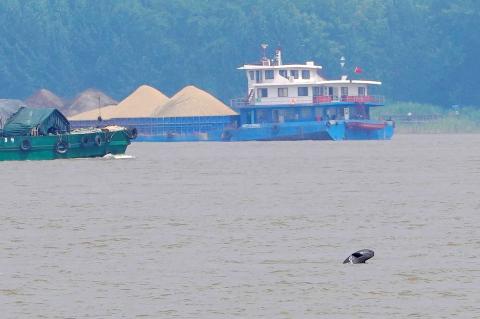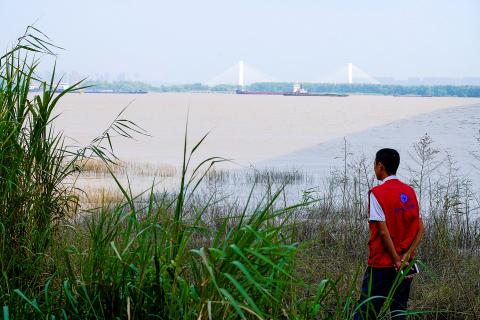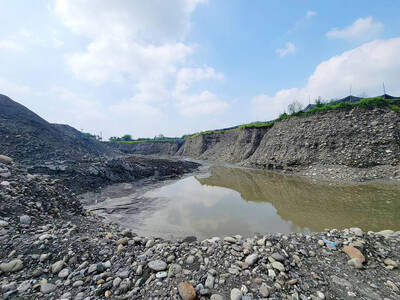On a short stretch of the Yangtze River, three sleek grey porpoises twist in muddy waters near the city of Nanjing, protected from passing barges and ships by a row of yellow buoys.
With only 1,000 remaining, the Yangtze finless porpoise is a symbol of the damage done to China’s longest river in a decades-long campaign to tame floods, reclaim farmland and industrialize the regions along its banks.
President Xi Jinping’s (習近平) call for sustainable growth in the Yangtze “economic belt” has raised hopes that the river’s last surviving mammal can become an emblem of China’s environmental revival.

Photo: Reuters
“It has now been scientifically proven that the Yangtze porpoise is a unique species,” said Jiang Meng, secretary general of the Nanjing Yangtze Finless Porpoise Conservation Association, a group that oversees the porpoise safe haven at Nanjing.
“If it isn’t protected well, the Chinese government will be under pressure,” Jiang said.
The safe zone is tucked behind a “ecological red line” that bans construction on 88 sq km of territory along the shore.

Photo: Reuters
Rows of fish farms have been replaced by lotus ponds teeming with migratory birds. Fishing is restricted and ships are routed away from the zone, which is patrolled daily.
“We chase them away — this is a core area so we can’t let them fish here,” said Yang Jinlong, a fisherman-turned-conservationist.
China counted 1,012 Yangtze porpoises in its last census in 2017, down from 2,500 in 1991, and the numbers are falling by about 10 percent a year, officials said.
The porpoise can still be saved, Jiang said.
“The numbers are still falling but the rate of decline is slowing,” he said.
It’s been done before, activists say. A decades-long conservation effort saved the giant panda, China’s national symbol, from the brink of extinction. There are around 1,900 giant pandas today, and their numbers are rising.
“It may be too little too late, but what they are doing is unprecedented,” Todd Robeck, author of a recent study into the Yangtze porpoise, said of the effort to save the mammal.
“They are putting in the right pieces to keep this animal from going extinct,” said Robeck, vice president of conservation research at SeaWorld Parks & Entertainment in Orlando, Florida.
From its origins in the glaciers of Tibet to its delta in Shanghai on the eastern coast, the 6,437km Yangtze provides water to a third of China’s population.
It has been the scene of profound and destructive environmental changes over the past 70 years, caused not only by giant feats of engineering like the Three Gorges Dam, but also a Mao Zedong (毛澤東)-era campaign to drain lakes and wetlands.
For decades, its complex ecosystem was sacrificed in a frantic rush for economic growth.
The “baiji” or white-finned dolphin, a larger cousin of the porpoise, was declared “functionally extinct” in 2006. The Chinese sturgeon is also on the brink of annihilation, with fish stocks plunging 90 percent in the last few decades.
Many porpoises are killed in collisions with boats because noise pollution affects their echolocation, while a degraded habitat and polluted water exposes them to contagious diseases.
A 10-year government action plan released in 2016 blamed “intensified human activities” for the fall in porpoise numbers and said past protection efforts failed to arrest the decline.
However, the action plan was limited in scope, aiming only to “stabilize” porpoise populations, improve monitoring, raise public awareness and deepen genetic and stem cell research.
Nanjing is considered a model protection zone, and it has spent around 30 million yuan since it opened in 2014 on surveillance equipment and a full-time staff of 20.
Elsewhere, authorities last month imposed a 10-year fishing ban from 2021 at Poyang, China’s largest freshwater lake and another home to finless porpoises. The ban will affect 100,000 fishermen, Xinhua news agency reported.
And a 64km stretch of the Yangtze at Anqing, in Anhui Province, has been declared a porpoise safe haven and off limits for fishing.
“We are optimistic because the state has made protection a priority,” said Chen Shouwen, a conservation official at Anqing’s rural affairs bureau.
Activists hope publicity will help save the porpoise, but some campaigns can misfire. Conservationists were enraged last year when authorities captured 14 wild porpoises and put them on display in marine parks in Shanghai and along the east coast.
Researchers have had some success in breeding porpoises artificially, but the numbers are small. China may be forced to preserve the species by storing reproductive cells and repopulating the river when conditions improve.
“I don’t think it will ever return to the way it was, but there might be some mitigation efforts where they can thrive quite normally in the Yangtze,” Robeck said. “I’m really hopeful their efforts will be an example for what can be done in the future.”

Next week, candidates will officially register to run for chair of the Chinese Nationalist Party (KMT). By the end of Friday, we will know who has registered for the Oct. 18 election. The number of declared candidates has been fluctuating daily. Some candidates registering may be disqualified, so the final list may be in flux for weeks. The list of likely candidates ranges from deep blue to deeper blue to deepest blue, bordering on red (pro-Chinese Communist Party, CCP). Unless current Chairman Eric Chu (朱立倫) can be convinced to run for re-election, the party looks likely to shift towards more hardline

Sept. 15 to Sept. 21 A Bhutanese princess caught at Taoyuan Airport with 22 rhino horns — worth about NT$31 million today — might have been just another curious front-page story. But the Sept. 17, 1993 incident came at a sensitive moment. Taiwan, dubbed “Die-wan” by the British conservationist group Environmental Investigation Agency (EIA), was under international fire for being a major hub for rhino horn. Just 10 days earlier, US secretary of the interior Bruce Babbitt had recommended sanctions against Taiwan for its “failure to end its participation in rhinoceros horn trade.” Even though Taiwan had restricted imports since 1985 and enacted

Enter the Dragon 13 will bring Taiwan’s first taste of Dirty Boxing Sunday at Taipei Gymnasium, one highlight of a mixed-rules card blending new formats with traditional MMA. The undercard starts at 10:30am, with the main card beginning at 4pm. Tickets are NT$1,200. Dirty Boxing is a US-born ruleset popularized by fighters Mike Perry and Jon Jones as an alternative to boxing. The format has gained traction overseas, with its inaugural championship streamed free to millions on YouTube, Facebook and Instagram. Taiwan’s version allows punches and elbows with clinch striking, but bans kicks, knees and takedowns. The rules are stricter than the

Last week the story of the giant illegal crater dug in Kaohsiung’s Meinong District (美濃) emerged into the public consciousness. The site was used for sand and gravel extraction, and then filled with construction waste. Locals referred to it sardonically as the “Meinong Grand Canyon,” according to media reports, because it was 2 hectares in length and 10 meters deep. The land involved included both state-owned and local farm land. Local media said that the site had generated NT$300 million in profits, against fines of a few million and the loss of some excavators. OFFICIAL CORRUPTION? The site had been seized